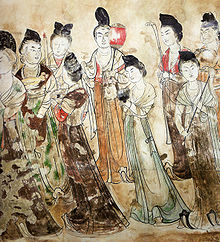Princess Yongtai
You can help expand this article with text translated from the corresponding article in Chinese. (June 2012) Click [show] for important translation instructions.
|


Li Xianhui (Chinese: 李仙蕙; pinyin: Lǐ Xiānhuì Wade-Giles Yung T'ai) (685 – October 9, 701[3][4]), courtesy name Nonghui (穠輝), known formally as Princess Yongtai (永泰公主) was a princess of the Tang Dynasty.
She was a daughter of the Emperor Zhongzong of Tang and Empress Wei. Her grandmother Wu Zetian, who had deposed Zhongzong after a brief first period of reign, heard a report of remarks she supposedly made, and had her flogged to death, or alternatively she was made to hang herself, in 701, and her husband and elder brother were also executed. This is the story the histories give, though her epitaph says she died in childbirth. After Wu Zetian's death, when her father again came to the throne, she and her brother were reburied in grand tombs in the Qianling Mausoleum in 705.[5]
Her tomb was discovered in 1960, and excavated from 1964. It had been robbed in the past, probably soon after the burial, and items in precious materials taken, but the thieves had not bothered with the over 800 pottery tomb figures, and the extensive frescos were untouched. The robbers had left in a hurry, leaving silver items scattered around, and the corpse of one of their number. The tomb had a flattened pyramid rising 12 metres above ground, and a long sloping entrance tunnel lined with frescos, leading to an ante-chamber and the tomb chamber itself, 12 metres below ground level with a high domed roof.[6] Most of the contents, including the frescos, are now in the Shaanxi History Museum.
Notes
- ^ The Tomb of Princess Yongtai. TravelChinaGuide. Retrieved 2008-02-11.
- ^ Shaanxi History Museum.
- ^ Tombstone of the Deceased Princess Yongtai of Tang.
- ^ Academia Sinica Chinese-Western Calendar Converter.
- ^ Watson, 136; Hay, 51
- ^ Watson, 136-141, Hay, passim throughout
References
- Hay, Jonathan, "Seeing through dead eyes: How early Tang tombs staged the afterlife", RES: Anthropology and Aesthetics, No. 57/58 (Spring/Autumn 2010), pp. 16-54, Peabody Museum of Archaeology and Ethnology, Harvard, JSTOR, academia.edu
- Watson, William, Genius of China (exhibition, Royal Academy of Arts), 1973, Times Newspapers Ltd, ISBN 0723001073
